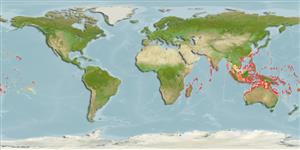Environment: milieu / climate zone / depth range / distribution range
Sinh thái học
Biển Cùng sống ở rạn san hô; Mức độ sâu 3 - 44 m (Ref. 90102). Tropical; 30°N - 33°S, 30°E - 137°W (Ref. 5222)
Indo-Pacific: Kenya south to Natal, South Africa and east to the central Pacific. Unknown from the Red Sea, Persian Gulf, and Hawaii. Recorded from Europa Island (MNHN 1992-0498, Ref. 33390). Often confused with Epinephelus quoyanus, Epinephelus faveatus, Epinephelus corallicola, and Epinephelus howlandi.
Bộ gần gũi / Khối lượng (Trọng lượng) / Age
Maturity: Lm ? range ? - ? cm
Max length : 51.0 cm TL con đực/không giới tính; (Ref. 4787); Khối lượng cực đại được công bố: 2.0 kg (Ref. 5222)
Các tia vây lưng cứng (tổng cộng) : 11; Các vây lưng mềm (tổng cộng) : 15 - 17; Tia cứng vây hậu môn: 3; Tia mềm vây hậu môn: 8. Head profile angular; body less compressed and spots more closely spaced than E. corallicola and E. howlandi (Ref. 37816). Body and median fins with large dark blotches, largest towards the tail (Ref. 48635); further characterized by pale greyish color; head, body and fins with well-spaced dark brown to orange brown spots of unequal size; soft dorsal, anal and caudal fins with narrow white to yellow margin; lower part of head and breast with white blotches; 3-4 black blotches along back; body scales cycloid except ctenoid on lower region below pectoral fins; body with numerous auxiliary scales; greatest depth of body 2.9-3.6 in SL; rounded caudal fin; pelvic fins 1.8-2.4 in head length (Ref. 90102); head length 2.3-2.6 times in SL; flat or slightly concave interorbital area, dorsal head profile of adults with ventral bend at orbits; rounded preopercle, minute serrae mostly covered by skin and shallow indentation just above the angle; straight or slightly convex upper edge of operculum posterior nostril distinctly larger than anterior nostril; maxilla reaches to or past vertical at rear edge of orbit, ventral edge smoothly curved at distal expansion; strongly projecting lower jaw, 2-4 rows of teeth at midlateral part (Ref. 89707).
Found in lagoon and seaward reefs (Ref. 9710) to a depth of at least 44 m; including outer reef slopes. More abundant on oceanic reefs and rare on coastal reefs (Ref. 89707). Feeds on crustaceans (mainly crabs), fishes, octopi, and squid. Solitary (Ref 90102).
Life cycle and mating behavior
Chín muồi sinh dục | Sự tái sinh sản | Đẻ trứng | Các trứng | Sự sinh sản | Ấu trùng
Heemstra, P.C. and J.E. Randall, 1993. FAO Species Catalogue. Vol. 16. Groupers of the world (family Serranidae, subfamily Epinephelinae). An annotated and illustrated catalogue of the grouper, rockcod, hind, coral grouper and lyretail species known to date. Rome: FAO. FAO Fish. Synop. 125(16):382 p. (Ref. 5222)
IUCN Red List Status (Ref. 130435: Version 2024-1)
Threat to humans
Harmless
Human uses
Các nghề cá: Tính thương mại
Các công cụ
Special reports
Download XML
Các nguồn internet
Estimates based on models
Preferred temperature (Ref.
123201): 24.7 - 29, mean 27.9 °C (based on 718 cells).
Phylogenetic diversity index (Ref.
82804): PD
50 = 0.5000 [Uniqueness, from 0.5 = low to 2.0 = high].
Bayesian length-weight: a=0.01072 (0.00699 - 0.01641), b=3.05 (2.93 - 3.17), in cm total length, based on LWR estimates for this species & Genus-body shape (Ref.
93245).
Mức dinh dưỡng (Ref.
69278): 3.8 ±0.5 se; based on diet studies.
Thích nghi nhanh (Ref.
120179): Trung bình, thời gian nhân đôi của chủng quần tối thiểu là 1.4 - 4.4 năm (Preliminary K or Fecundity.).
Fishing Vulnerability (Ref.
59153): Moderate vulnerability (40 of 100).
Nutrients (Ref.
124155): Calcium = 28.4 [13.9, 60.3] mg/100g; Iron = 0.484 [0.265, 0.991] mg/100g; Protein = 18.5 [17.0, 19.9] %; Omega3 = 0.118 [0.074, 0.185] g/100g; Selenium = 32.3 [19.5, 56.8] μg/100g; VitaminA = 189 [53, 675] μg/100g; Zinc = 1.34 [0.94, 1.86] mg/100g (wet weight);
